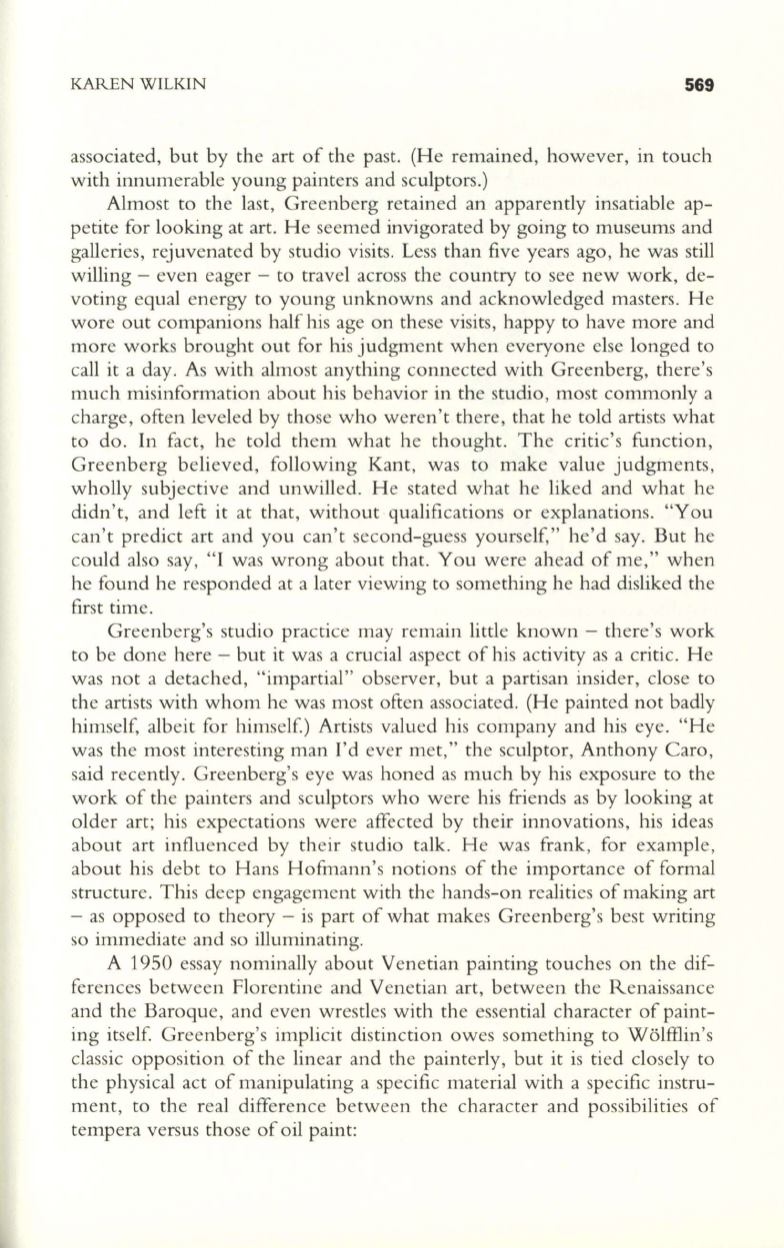
KAREN WILKIN
569
associated, but by the art of the past. (He remained, however, in touch
with innumerable young painters and sculptors.)
Almost to the last, Greenberg retained an apparently insatiable ap–
petite for looking at art. He seemed invigorated by going to museums and
galleries, rejuvenated by studio visits. Less than five years ago, he was still
willing - even eager - to travel across the country to see new work, de–
voting equal energy to young unknowns and acknowledged masters. He
wore out companions half his age on these visits, happy to have more and
more works brought out for his judgment when everyone else longed to
call it a day. As with almost anything connected with Greenberg, there's
much misinformation about his behavior in the studio, most commonly a
charge, often leveled by those who weren't there, that he told artists what
to do.
In
fact, he told them what he thought. The critic's function,
Greenberg believed , following Kant, was to make value judgments,
wholly subjective and unwilled. He stated what he liked and what he
didn't, and left it at that, without qualifications or explanations. "You
can't predict art and you can't second-guess yourself," he'd say. But he
could also say, "I was wrong about that. You were ahead of me," when
he found he responded at a later viewing to something he had disliked the
first time.
Greenberg's studio practice may remain little known - there's work
to be done here - but it was a crucial aspect of his activity as a critic. He
was not a detached, "impartial" observer, but a partisan insider, close to
the artists with whom he was most often associated. (He painted not badly
himself, albeit for himself) Artists valued his company and his eye. "He
was the most interesting man I'd ever met," the sculptor, Anthony Caro,
said recently. Greenberg's eye was honed as much by his exposure to the
work of the painters and sculptors who were his friends as by looking at
older art; his expectations were affected by their innovations, his ideas
about art influenced by their studio talk. He was frank, for example,
about his debt to Hans Hofmann's notions of the importance of formal
structure. This deep engagement with the hands-on realities of making art
- as opposed to theory - is part of what makes Greenberg's best writing
so immediate and so illuminating.
A 1950 essay nominally about Venetian painting touches on the dif–
ferences between Florentine and Venetian art, between the Renaissance
and the Baroque, and even wrestles with the essential character of paint–
ing itself Greenberg's implicit distinction owes something to W6lffiin's
classic opposition of the linear and the painterly, but it is tied closely to
the physical act of manipulating a specific material with a specific instru–
ment, to the real difference between the character and possibilities of
tempera versus those of oil paint:


